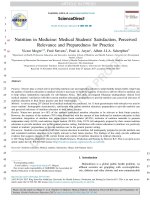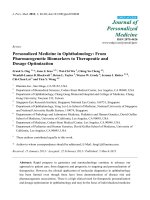Pediatric emergency medicine trisk 561
Bạn đang xem bản rút gọn của tài liệu. Xem và tải ngay bản đầy đủ của tài liệu tại đây (153.29 KB, 4 trang )
Other Acquired Disorders of Hemostasis
As discussed above, acquired disorders of hemostasis include liver disease, vitamin K
deficiency, and development of inhibitors to VWF or other coagulation factor proteins,
often in the setting of an autoimmune condition. Patients with chronic liver disease and
vitamin K deficiency may benefit from vitamin K supplementation. When patients have
bleeding, replacement of factor deficiencies and platelets, if low, may be useful. Patients
with renal failure require optimal management of their uremia and may benefit from
platelet transfusion in the right clinical setting. For patients who develop inhibitors to
coagulation factors (acquired hemophilia), management is complex and should involve a
hematologist.
Clinical Indications for Discharge or Admission
Patients with uncontrolled bleeding or with clinical concern for bleeding risk should be
admitted for ongoing inpatient management and diagnostic evaluation if necessary. If a
bleeding disorder is suspected on the basis of initial laboratories or patient or family
history, but the child is not actively bleeding, additional evaluation may occur in the
outpatient setting with a hematology consultation.
HEMOPHILIA
Goals of Treatment
Early identification of bleeding in hemophilia patients is crucial for treating lifethreatening bleeds and preventing the long-term sequelae of recurrent joint bleeding.
CLINICAL PEARLS AND PITFALLS
Drugs that interfere with platelet function (e.g., aspirin, NSAIDs) should not
be given to patients with hemophilia.
Emicizumab, used for prophylaxis in hemophilia A, interferes with standard
coagulation assays, artificially shortening the aPTT and increasing FVIII
activity levels.
Current Evidence
Hemophilia A (factor VIII deficiency) and hemophilia B (factor IX deficiency) are Xlinked disorders of hemostasis. Hemophilia A accounts for roughly 85% of cases
(incidence ∼1:5,000 males), and hemophilia B for the remaining 15% (incidence
∼1:30,000 males). The bleeding phenotype can usually be predicted from the level of
factor coagulant activity. If factor activity is less than 1% (severe hemophilia), bleeding
episodes can occur spontaneously. Patients with moderate hemophilia (factor level
between 1% and <5%) and mild hemophilia (factor level between 5% and 50%)
typically do not have spontaneous hemorrhage but may have severe bleeds related to
trauma and procedures. Prophylactic administration of factor replacement to reduce the
frequency of spontaneous bleeding is standard care in adults and children with severe
disease.
Clinical Considerations
Clinical Recognition
The most common bleeding events for hemophilia patients include hemarthrosis (joint
bleed), muscle bleed, and subcutaneous bleed. These episodes may be spontaneous or
associated with trauma. Patients with hemophilia usually know when they have a bleed
prior to any clinical findings. Signs of early hemarthrosis include a sensation of
bubbling or tingling within the joint, joint discomfort that may accompany mild edema,
or slight reduction in range of motion. As an untreated or inadequately treated bleed
progresses, swelling, erythema, warmth, difficulty bearing weight and limited range of
motion will become evident. Bleeds within a muscle may present similarly; however,
tenderness and edema will localize to a muscle, and ecchymosis may or may not be
present. Distinguishing between hip hemorrhage and an iliopsoas bleed may be difficult
but is clinically very important since retroperitoneal bleeds can become life threatening.
An iliopsoas bleed will produce severe pain with hip flexion and extension but minimal
pain with hip rotation. Iliopsoas bleeds may cause compression of the lateral femoral
nerve resulting in numbness. Hip bleeds, on the other hand, produce severe pain with
hip rotation and mild pain with flexion or extension.
A patient’s disease severity should also inform a clinician’s level of clinical concern.
For example, after mild head trauma, the patient with severe hemophilia (not recently
infused) is at greater risk of developing intracranial bleeding than the patient with mild
hemophilia and must be evaluated and managed more aggressively. On the other hand, if
a patient with mild hemophilia presents with extensive hemorrhage, there should be a
heightened suspicion for significant trauma and possible associated injury to internal
organs.
Neutralizing alloantibodies (inhibitors) against factors occur in 20% to 30% of
children with severe factor VIII deficiency and 3% to 5% of individuals with severe
factor IX deficiency. Inhibitor development is influenced by the severity of hemophilia,
age, genetics, number of prior factor infusions, and the intensity of early exposures to
factor products. Inhibitors do not change the typical sites, frequency or severity of
bleeding, but they make timely and adequate control of bleeding more challenging.
Inhibitors are measured in Bethesda units (BU) where one BU equals the amount of
inhibitor in 1 mL of plasma that destroys 50% of factor VIII or IX. High-titer inhibitors
are considered greater than 5 BU. Immune tolerance induction (ITI) is the only
demonstrated approach to inhibitor eradication. The recognition of a newly developed
inhibitor occurs when response to previously effective therapy is insufficient or may be
detected on routine outpatient monitoring. Current inhibitor level will not result during
the initial management of an emergent bleed. If there is clinical suspicion of an
inhibitor, post factor infusion aPTT or a mixing study may be supportive. In the
presence of a high-titer inhibitor, a level of factor activity adequate to normalize the
aPTT (20% to 40% factor VIII) is rarely achieved with standard doses of factor
replacement and aPTT is not correctable mixing the patient’s plasma with normal
plasma.
Triage
Bleeding emergencies in hemophilia patients should be promptly identified and treated.
Infusion of factor replacement prior to completing radiologic evaluation is appropriate
to avoid unnecessary delays in the treatment. Life- and limb-threatening bleeds in
hemophilia patients include intracranial hemorrhage, iliopsoas bleeds, gastrointestinal
bleeds, and compartment syndrome. Additionally, children with hemophilia will present
with the same surgical emergencies that affect children with normal hemostasis and will
require prompt administration of factor. Early hematology consultation is warranted for
any patient with hemophilia anticipated to need operative or procedural intervention.
Management/Diagnostic Testing
The primary treatment for hemophilia is infusion of factor VIII or factor IX concentrate.
Factor concentrate is manufactured as a lyophilized (freeze-dried) powder from either
recombinant-DNA derived factor protein or plasma-derived protein that has been treated
to attenuate possible viral contaminants from donors. The management of the patients
with hemophilia is dictated by type and severity of bleed ( Table 93.12 ). In general,
goal hemostatic factor levels for mild–moderate bleeding are 35% to 50% and for
severe/life-threatening bleeding or surgical procedures are 100%.
The aPTT may be normal when the factor VIII or IX level is as low as 20% to 40%
depending on the assay method and normal ranges selected. Measurement of the factor
coagulant level is needed to assess the adequacy of response to treatment when levels
above 30% are desired. Although the aPTT need not be measured after routine treatment
of minor hemorrhages, it can be useful in demonstrating a response to factor
replacement in the setting of major hemorrhage or prior to operative management. If a
minor bleed fails to respond to conventional dosing, a pre- and posttreatment factor
level should be measured to be certain that the desired level is being achieved. Consider
the possibility of a newly developed inhibitor in this setting.
TABLE 93.12
TREATMENT GUIDANCE FOR BLEEDING IN HEMOPHILIA









